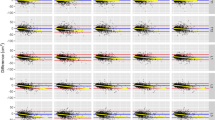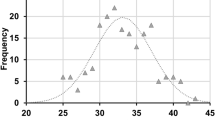Abstract
Purpose
The purpose of the study is to determine whether a novel semi-automated DIXON-based fat quantification algorithm can reliably quantify visceral fat using a CT-based reference standard.
Methods
This was an IRB-approved retrospective cohort study of 27 subjects who underwent abdominopelvic CT within 7 days of proton density fat fraction (PDFF) mapping on a 1.5T MRI. Cross-sectional visceral fat area per slice (cm2) was measured in blinded fashion in each modality at intervertebral disc levels from T12 to L4. CT estimates were obtained using a previously published semi-automated computational image processing system that sums pixels with attenuation − 205 to − 51 HU. MR estimates were obtained using two novel semi-automated DIXON-based fat quantification algorithms that measure visceral fat area by spatially regularizing non-uniform fat-only signal intensity or de-speckling PDFF 2D images and summing pixels with PDFF ≥ 50%. Pearson’s correlations and Bland–Altman analyses were performed.
Results
Visceral fat area per slice ranged from 9.2 to 429.8 cm2 for MR and from 1.6 to 405.5 cm2 for CT. There was a strong correlation between CT and MR methods in measured visceral fat area across all studied vertebral body levels (r = 0.97; n = 101 observations); the least (r = 0.93) correlation was at T12. Bland–Altman analysis revealed a bias of 31.7 cm2 (95% CI [− 27.1]–90.4 cm2), indicating modestly higher visceral fat assessed by MR.
Conclusion
MR- and CT-based visceral fat quantification are highly correlated and have good cross-modality reliability, indicating that visceral fat quantification by either method can yield a stable and reliable biomarker.




Similar content being viewed by others
References
Garg K, Chang S, Scherzinger A (2013) Obesity and diabetes: newer concepts in imaging. Diabetes Technol Ther 15:351–361
Shuster A, Patlas M, Pinthus JH, et al. (2012) The clinical importance of visceral adiposity: a critical review of methods for visceral adipose tissue analysis. Br J Radiol 85:1–10
Balentine CJ, Marshall C, Robinson C, et al. (2010) Validating quantitative obesity measurements in colorectal cancer patients. J Surg Res 164:18–22
Shen W, Wang Z, Punyanita M, et al. (2003) Adipose tissue quantification by imaging methods: a proposed classification. Obes Res 11:5–16
Furukawa K, Katabami T, Nakajima Y, et al. (2010) Evaluation of a whole-abdominal fat volume by 700-slice CT scanning and comparison with the umbilical fat area anthropometric indices. Obes Res Clin Pract 4:111–117
Demerath EW, Reed D, Rogers N, et al. (2008) Visceral adiposity and its anatomical distribution as predictors of the metabolic syndrome and cardiometabolic risk factor levels. Am J Clin Nutr 88:1263–1271
Doyle SL, Bennett AM, Donohoe CL, et al. (2013) Establishing computed tomography-defined visceral fat area thresholds for use in obesity-related cancer research. Nutr Res 33:171–179
Abdelbadee AY, Paspulati RM, McFarland HD, et al. (2016) Computed tomography morphometrics and pulmonary intolerance in endometrial cancer robotic surgery. J Minim Invas Gynecol 23:1075–1082
Locke JE, Carr JJ, Sangeeta N, et al. (2017) Abdominal lean muscle is associated with lower mortality among kidney waitlist candidates. Clin Transplant 31:e12911
Sabel MS, Terjimanian M, Conlon ASC, et al. (2013) Analytic morphometric assessment of patients undergoing colectomy for colon cancer. J Surg Oncol 108:169–175
Van Der Sloot KWJ, Joshi AD, Bellavance DR, et al. (2017) Visceral adiposity, genetic susceptibility, and risk of complications among individuals with Crohn’s disease. Inflamm Bowel Dis 23:82–88
Demerath EW, Shen W, Lee M, et al. (2007) Approximation of total visceral adipose tissue with a single magnetic resonance image. Am J Clin Nutr 85:362–368
Schweitzer L, Geisler C, Pourhassan M, et al. (2015) What is the best reference site for a single MRI slice to assess whole-body skeletal muscle and adipose tissue volumes in healthy adults? Am J Clin Nutr 102:58–65
Shen W, Punyanitya M, Wang Z, et al. (2004) Total body skeletal muscle and adipose tissue volumes: estimation from a single abdominal cross-sectional image. J Appl Physiol 97:2333–2338
Bosy-Westphal A, Later W, Hitze B, et al. (2008) Accuracy of bioelectrical impedance consumer devices for measurement of body composition in comparison to whole body magnetic resonance imaging and dual X-ray absorptiometry. Obes Facts 1:319–324
Stewart KJ, DeRegis JR, Turner KL, et al. (2003) Usefulness of anthropometrics and dual-energy x-ray absorptiometry for estimating abdominal obesity measured by magnetic resonance imaging in older men and women. J Cardiopulm Rehabil 23:109–114
O’Connor M, Ryan J, Foley S (2015) Best single-slice location to measure visceral adipose tissue on paediatric CT scans and the relationship between anthropometric measurements, gender and VAT volume in children. Br J Radiol 88:20140711
Lee S, Kuk JL, Kim Y, et al. (2011) Measurement site of visceral adipose tissue and prediction of metabolic syndrome in youth. Pediatr Diabetes 12:250–257
Li X, Youngren JF, Hyun B, et al. (2008) Technical evaluation of in vivo abdominal fat and IMCL quantification using MRI and MRSI at 3T. Magn Reson Imaging 26:188–197
Seidell JC, Bakker CJG, van der Kooy K (1990) Imaging techniques for measuring adipose-tissue distribution—a comparison between computed tomography and 1.5T magnetic resonance. Am J Clin Nutr 51:953–957
Kuk JL, Church TS, Blair SN, et al. (2010) Measurement site and the association between visceral and abdominal subcutaneous adipose tissue with metabolic risk in women. Obesity 18:1336–1340
Shen W, Punyanitya M, Chen J, et al. (2007) Visceral adipose tissue: relationships between single slice areas at different locations and obesity-related health risks. Int J Obes 31:763–769
Reeder SB, Hu HH, Sirlin CB (2012) Proton density fat-fraction: a standardized MR-based biomarker of tissue fat concentration. J Magn Reson Imaging 36:1011–1014
Stidham RW, Waljee AK, Day NM, et al. (2015) Body fat composition assessment using analytic morphomics predicts infectious complications after bowel resection in Crohn’s disease. Inflamm Bowel Dis 21:1306–1313
Klopfenstein BJ, Kim MS, Krisky CM, et al. (2012) Comparison of 3T MRI and CT for the measurement of visceral and subcutaneous adipose tissue in humans. Br J Radiol 85:826–830
Gomi T, Kawawa Y, Nagamoto M, et al. (2005) Measurement of visceral fat/subcutaneous fat ratio by 0.3 Tesla MRI. Radiat Med 23:584–587
Kullberg J, Brandberg J, Angelhed JE, et al. (2009) Whole-body adipose tissue analysis: comparison of MRI, CT and dual energy X-ray absorptiometry. Br J Radiol 82:123–130
Stolk RP, Wink O, Zelissen PMJ, et al. (2011) Validity and reproducibility of ultrasonography for the measurement of intra-abdominal adipose tissue. Int J Obes 25:1346–1351
Middleton MS, Haufe W, Hooker J, et al. (2017) Quantifying abdominal adipose tissue and thigh muscle volume and hepatic proton density fat fraction: repeatability and accuracy of an MR imaging-based semiautomated analysis method. Radiology 283:438–449
Davenport MS, Neville AM, Ellis JH, et al. (2011) Diagnosis of renal angiomyolipoma with Hounsfield unit thresholds: effect of size of region of interest and nephrographic phase imaging. Radiology 260:158–165
Author information
Authors and Affiliations
Corresponding author
Ethics declarations
No funding was solicited or used for this work. Institutional review board approval was obtained. The requirement for informed consent was waived by the IRB. All procedures performed in studies involving human participants were in accordance with the ethical standards of the institutional and/or national research committee and with the 1964 Helsinki Declaration and its later amendments or comparable ethical standards.
Financial disclosure
Matthew Davenport—Royalties from Wolters Kluwer, Katherine M. Heckman—No conflict of interest, Bamidele Otemuyiwa—No conflict of interest, Thomas L. Chenevert—No conflict of interest, Dariya Malyarenko—No conflict of interest, Brian A. Derstine—No conflict of interest, Stewart C Wang—No conflict of interest.
Rights and permissions
About this article
Cite this article
Heckman, K.M., Otemuyiwa, B., Chenevert, T.L. et al. Validation of a DIXON-based fat quantification technique for the measurement of visceral fat using a CT-based reference standard. Abdom Radiol 44, 346–354 (2019). https://doi.org/10.1007/s00261-018-1678-x
Published:
Issue Date:
DOI: https://doi.org/10.1007/s00261-018-1678-x




